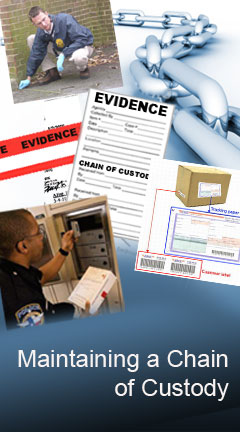Archival Notice
This is an archive page that is no longer being updated. It may contain outdated information and links may no longer function as originally intended.
Home | Glossary | Resources | Help | Course Map
Documenting the chain of custody literally requires each person who touches an item of evidence to
Maintaining a Chain of Custody
- The same person or persons that recovered the evidence should initial, seal and send the evidence, or deliver it to an evidence locker.
- The law enforcement agency (court, police station or lab) should maintain the evidence in a locked vault, cabinet or room until it must be shipped or is needed for tests, discovery or trial.
- The person who is shipping or transporting an item of evidence should use a reliable shipping method that can accurately track items shipped.
- Each person who takes physical custody of an evidence item must sign for it as custody is taken.
Additional Online Courses
- What Every First Responding Officer Should Know About DNA Evidence
- Collecting DNA Evidence at Property Crime Scenes
- DNA – A Prosecutor’s Practice Notebook
- Crime Scene and DNA Basics
- Laboratory Safety Programs
- DNA Amplification
- Population Genetics and Statistics
- Non-STR DNA Markers: SNPs, Y-STRs, LCN and mtDNA
- Firearms Examiner Training
- Forensic DNA Education for Law Enforcement Decisionmakers
- What Every Investigator and Evidence Technician Should Know About DNA Evidence
- Principles of Forensic DNA for Officers of the Court
- Law 101: Legal Guide for the Forensic Expert
- Laboratory Orientation and Testing of Body Fluids and Tissues
- DNA Extraction and Quantitation
- STR Data Analysis and Interpretation
- Communication Skills, Report Writing, and Courtroom Testimony
- Español for Law Enforcement
- Amplified DNA Product Separation for Forensic Analysts


